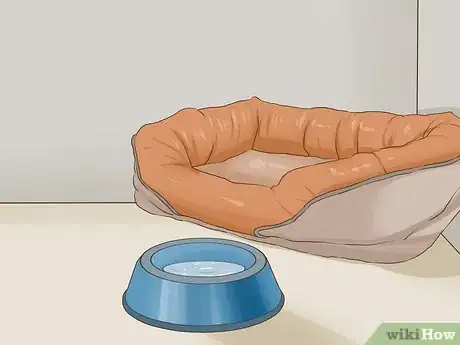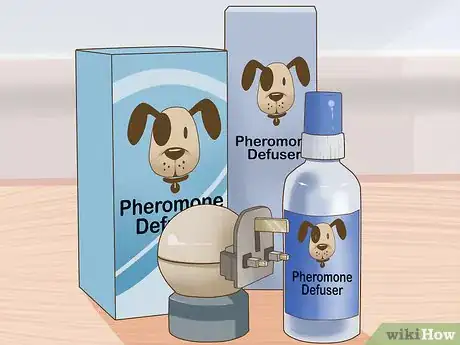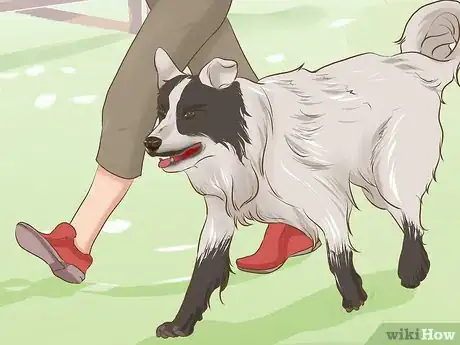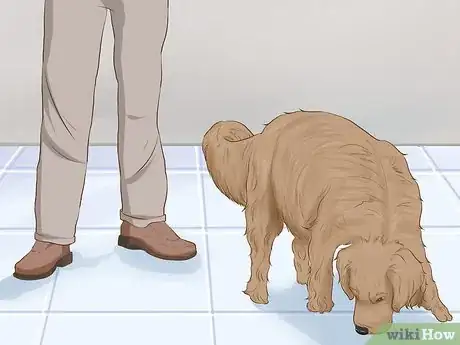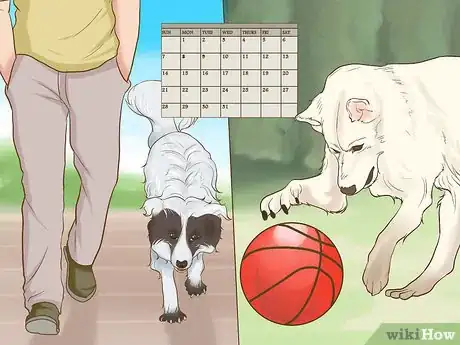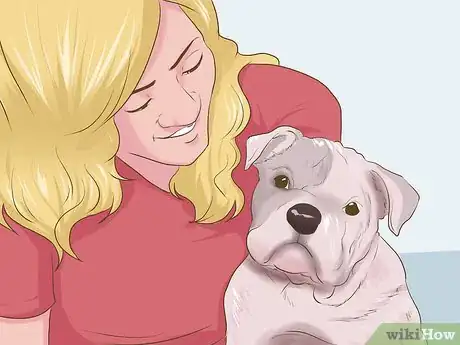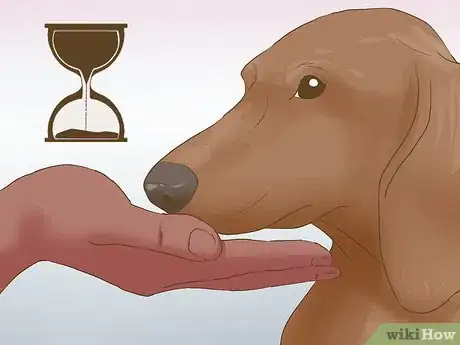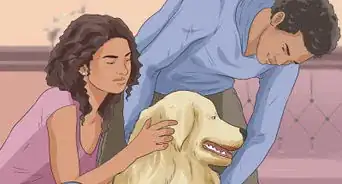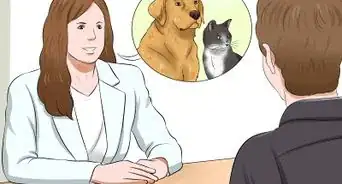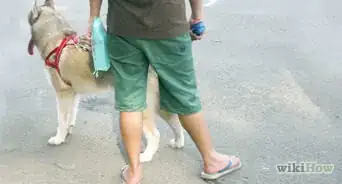This article was co-authored by Melissa Nelson, DVM, PhD. Dr. Nelson is a Veterinarian who specializes in Companion and Large Animal Medicine in Minnesota, where she has over 18 years of experience as a veterinarian in a rural clinic. She received her Doctor of Veterinary Medicine from the University of Minnesota in 1998.
This article has been viewed 22,886 times.
Dogs can get very attached to their homes and so moving can be a very stressful and unpleasant experience for them. In order to reduce this stress as much as possible, and to have the dog get a good start at its new home, it should be introduced to its new space very intentionally. Although you will be very busy with moving, you need to take some time to introduce the dog to the outside and inside of its new home in a calm and supervised manner. You will also want to establish the dog's normal routine and rules as quickly as possible, in order for it to begin adjusting to its new home more easily.
Steps
Bringing the Dog Home
-
1Place the dog's things in the home. If at all possible, put the dog's bed and toys, as well as its water and food dishes, inside the home before the dog gets there. This will let the dog know that this is its space now and it will be comforting to have familiar things and smells.
- Put the dog's items in locations that are similar to where they were in its old home. This will add to the dog's level of comfort.
- Keep the dog's belongings. When you move to a new place you should not get the dog all new toys and a new bed. The things that the dog already has have its smells all over them and they will provide it with comfort during the adjustment period.[1]
-
2Clean your floors using a professional-grade cleaner. Rent something like a carpet shampooer or hire a cleaning company to clean your carpet before your new dog comes home. This will get rid of odors from any previous tenants or owners that could attract your new dog and encourage them to mark those areas.Advertisement
-
3Consider using a pheromone diffuser. In order to make the house smell appealing to the dog, and override any smells that might be there from the last tenant, you can use a pheromone diffuser. Pheromone diffusers release a synthetic pheromone into the air that humans cannot smell but that mimics the comforting pheromones released by mother dogs when they have puppies.[2]
- While pheromones don't work on all dogs, they are very helpful for calming a lot of dogs when they are stressed out.
- Pheromone diffusers are available at most pet stores, online, and through your veterinary office.
-
4Walk the dog around the outside of the home.[3] In order to let the dog fully familiarize itself with its new home, let it explore the area around the home for a little while before entering it. This will help the dog assess its new domain and establish the boundaries of its new home.
- Have the dog go to the bathroom outside before it goes inside. This will help the dog establish its normal daily patterns at the new home quickly. If you have it go to the bathroom where you want it to go in the future, this will help that pattern occur reliably more quickly.
-
5Introduce the dog to one room at a time. It is a good idea to let the dog get to know its new home slowly. This will allow the dog to fully explore the whole place without getting overwhelmed or uneasy. Keep the dog on a leash when you bring it into the house. Let it sniff around one room at a time while you keep it on leash.[4]
- Don't feel like you have to let the dog explore every room immediately. If the dog will mainly be in the living room and the kitchen, for example, just introduce those rooms and keep the rest of the home blocked off.
- Once the dog has thoroughly sniffed the main areas, you can let it off lease. However, you should keep an eye on it for awhile to make sure it is behaving well in the new space.
- Do not just let the dog run free around its new home. You don't want it getting too riled up and you want to keep normal boundaries and rules in place even at the new home.
Helping the Dog Adjust
-
1Be consistent. Don't change the dog's schedule completely just because you moved. Also, keep the rules the same. Don't change the rules just because you feel bad that the dog is having to adjust to a new home. If you can keep this stuff the same, this predictability will be a great comfort to the dog. For example:[5]
- Feed the dog on the same schedule.
- Walk the dog on the same schedule.
- Go to bed at the same time.
- Play with the dog in the same way and at the same time as you used to.
- Don't allow new behaviors that weren't allowed before.
-
2Give the dog lots of attention. It's important to let the dog know that it is still important to you, despite all the changes going on. Give it your usual level of attention but its always good to give it a little more just to show it that the new home is a good place that has new and exciting perks.[6]
- If you are very busy due to the move and will not be able to give the dog your usual level of attention, then have someone else care for the dog while you are moving and putting things away in your new home. That way, when you actually bring the dog to its new home you can shower it with love and attention.
-
3Be patient. It may take some time for your dog to adjust to its new surroundings. It may pace, bark, howl, or act strangely for awhile after the mover. Show it love, compassion, and understanding since the change was unexpected and happened abruptly for the dog.[7]
- The dog could even begin to show behavioral problems that it never had before. If this is the case, you will need to work on the problem with training or with a professional dog behaviorist.
- Some common behavioral problems that can occur when a dog moves include separation anxiety and territorial issues, among others.
References
- ↑ http://www.vcahospitals.com/main/pet-health-information/article/animal-health/moving-with-your-dog/168
- ↑ http://www.vcahospitals.com/main/pet-health-information/article/animal-health/moving-with-your-dog/168
- ↑ http://www.barkbusters.com/dog-training-tips-moving-tips-helping-your-dog-ease-into-your-new-home
- ↑ http://www.vcahospitals.com/main/pet-health-information/article/animal-health/moving-with-your-dog/168
- ↑ http://www.aarp.org/relationships/pets/info-06-2011/pet-moving-tips.html
- ↑ http://www.aarp.org/relationships/pets/info-06-2011/pet-moving-tips.html
- ↑ http://www.aarp.org/relationships/pets/info-06-2011/pet-moving-tips.html
About This Article
To introduce your dog to its new home when you move, place its bed, toys, and food dishes inside before your dog arrives, if possible. Your dog will be comforted by the familiar things and smells. To get rid of unfamiliar odors from previous occupants, clean your floors and carpets with a professional-grade cleaner. You can also use a pheromone diffuser to override any unfamiliar odors and make your dog feel calmer. When your dog arrives, walk it around the house on a leash one room at a time to allow it to fully explore the whole place without getting overwhelmed or uneasy. For more tips from our Veterinary co-author, like how to keep your dog’s schedule consistent in your new home, keep reading!
